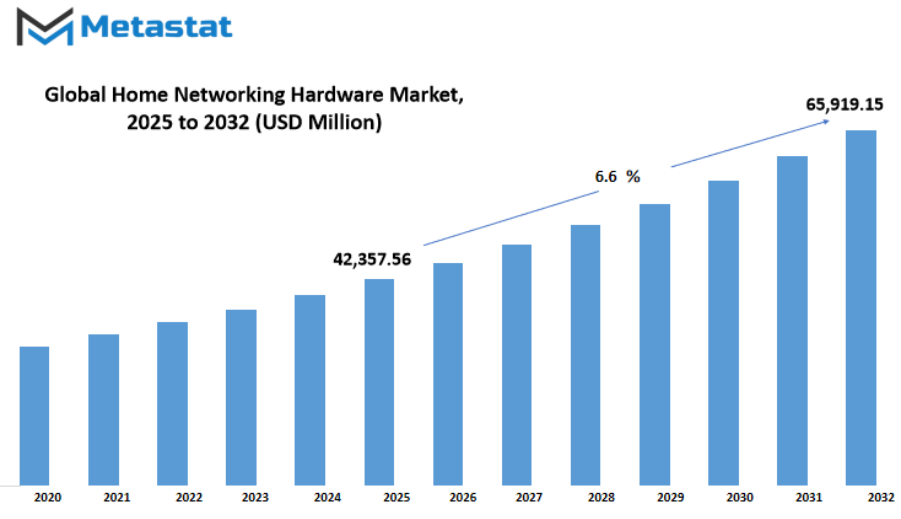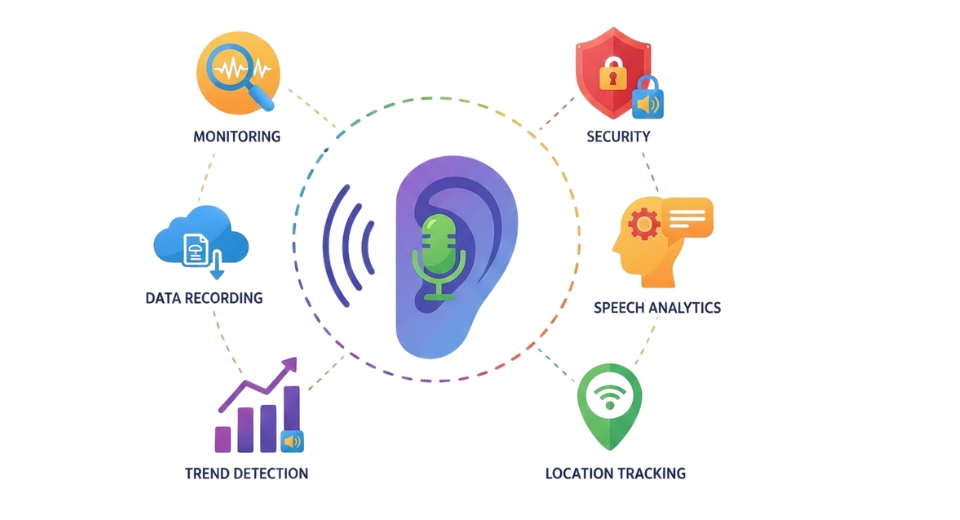MARKET OVERVIEW
The global home networking hardware market will dictate the manner in which homes engage with technology in the future, giving rise to the foundation of networking living spaces. This market encompasses the physical products that will facilitate the ease of communication among several digital items within a residential setting. From basic wireless routers to sophisticated mesh networks and network switches, the hardware will not only link devices but also enable the increasing need for greater, more secure data transfer. With homes relying more and more on smart appliances, the equipment will improve to accommodate increased bandwidths, lower latency, and enhanced security protocols.
In the future, home networking hardware will go beyond simply internet sharing. It will form an invisible infrastructure in which devices from entertainment systems to smart appliances talk to each other in real time. The market will witness innovations to eliminate dead spots, block congested traffic, and provide uniform performance to multiple users simultaneously. Handling simultaneous connections without disruption will no longer be a luxury but a family expectation.
The difference the next generation of this industry will make is that intelligent network management capabilities will be integrated directly into the hardware. Hardware will automatically optimize bandwidth allocation depending on activity type, either streaming ultra-high-definition material, online gaming, or controlling home automation systems. This will turn home networking from a passive installation to an active, responsive part of everyday life.
Security will be another hallmark feature. As more personal and sensitive information passes across domestic networks, future devices will be designed with robust defense against outside attack. This will not just extend to encryption but to real-time threat detection and automatic countermeasures integrated at the device level. Vendors will create solutions that provide enhanced safeguards without requiring technical savvy on the part of the user, ensuring security is seamless and transparent.
Energy efficiency will also play a role in the direction of the market. With more focus on green technology, future hardware will probably be less power-hungry without compromising performance. Slimmer designs and modular setups will enable families to swap out only the parts that need to be replaced without necessarily replacing entire systems, minimizing electronic waste and staying in tune with technology progression.
Global distribution will increase further, and devices will evolve to meet different regional conditions for infrastructure. In a few places, hardware will concentrate on compatibility with new high-speed fiber networks, while elsewhere the focus will be on reliability in less uniform service conditions. This versatility will render the global home networking hardware market a key facilitator of global digital access.
In the future, the industry will not only provide means to access the internet. It will establish the bases for intelligent, interconnected homes that can sense and react to their residents' needs. The next few years will witness hardware taking an active role in defining the digital way of life, with performance, reliability, and adaptability establishing the course of the user experience.
Global home networking hardware market is estimated to reach $65,919.15 Million by 2032; growing at a CAGR of 6.6% from 2025 to 2032.

GROWTH FACTORS
The global home networking hardware market is expected to grow steadily in the coming years, driven by rising demand for high-speed internet connectivity and the increasing number of connected devices in households. As more people work from home, study online, and use smart appliances, the need for reliable networking hardware will continue to increase. Devices such as routers, modems, and range extenders are becoming essential parts of modern homes, and advancements in wireless technology will further improve their performance. With faster data transfer speeds and better coverage, consumers will enjoy smoother streaming, online gaming, and remote work experiences.
One of the key driving factors of the global home networking hardware market is the growing adoption of smart home systems. From voice-controlled assistants to connected lighting and security cameras, the demand for efficient home networks is stronger than ever. The spread of 5G technology will also boost the market, as it will enable faster and more stable connections. Additionally, the trend of remote healthcare and online education will push more households to upgrade their networking equipment to handle higher bandwidth requirements.
However, there are factors that might hamper the market’s growth. One of the main challenges is the high cost of advanced networking devices, which can discourage adoption in price-sensitive regions. Another limiting factor is cybersecurity concerns, as connected devices can be vulnerable to hacking and data breaches. These issues can make some consumers hesitant to invest in new networking solutions.
Despite these challenges, the future outlook for the global home networking hardware market remains positive. The rapid development of Internet of Things (IoT) devices and the integration of artificial intelligence in network management will create new opportunities. For example, smart routers that automatically optimize bandwidth and detect security threats will attract tech-savvy buyers. The expansion of fiber-optic internet to more regions will also encourage consumers to invest in better hardware to take full advantage of faster speeds.
In the coming years, as technology becomes more integrated into everyday life, the demand for efficient and secure home networks will continue to grow. Manufacturers that focus on innovation, affordability, and user-friendly designs will be best positioned to benefit. While challenges remain, the combination of rising connectivity needs and emerging technologies will open the door for significant growth. The global home networking hardware market will not only shape how people connect at home but also influence how they live, work, and interact in a highly connected world.
MARKET SEGMENTATION
By Product Type
The global home networking hardware market is steadily gaining importance as households become increasingly dependent on connected devices for work, education, entertainment, and daily communication. By 2025, this market is expected to reflect significant valuations across various product categories, showing how essential these devices have become in supporting modern lifestyles. Among the segments, routers are projected to hold the highest value at USD 18,159.25 million. Their dominance comes from their central role in managing internet connections, supporting high-speed data transfer, and providing stable connectivity for multiple devices at once. As internet usage continues to grow, routers will not only remain in demand but will also evolve with advanced security features and higher bandwidth capabilities.
Modems, with an expected value of USD 6,736.73 million in 2025, will continue to serve as the gateway between home networks and internet service providers. While some devices combine router and modem functions, dedicated modems still have a strong market due to their reliability and ability to support faster upgrades in network performance. Wireless access points, valued at USD 4,197.56 million, will see steady adoption, especially in larger homes and buildings where a single router cannot cover every corner effectively. They will play an important role in expanding WiFi coverage and supporting the growing number of smart home devices.
Range extenders, expected to reach USD 4,521.63 million, will remain a convenient option for users who want to improve connectivity in areas where the signal is weak. Although mesh WiFi systems are gaining popularity, range extenders will continue to be preferred in many households due to their affordability and ease of installation. Mesh WiFi systems themselves are projected to hold a strong position with a valuation of USD 5,586.94 million, as they offer seamless coverage across entire properties without the signal drops often experienced with traditional setups. These systems will likely become more intelligent, automatically adjusting performance based on user activity and device location.
The other category, worth USD 3,155.46 million, will include emerging technologies and accessories that support network efficiency, security, and convenience. This may involve network switches, powerline adapters, and future hardware innovations designed to integrate with evolving home automation systems. Looking forward, the global home networking hardware market will not only expand in size but also shift toward solutions that balance speed, coverage, energy efficiency, and cybersecurity. As homes become smarter and more connected, the demand for reliable and adaptable networking hardware will continue to grow, making this market an important part of the digital future.
By Connectivity Technology
The global home networking hardware market is expected to grow steadily in the coming years as technology continues to shape the way people live, work, and communicate. Homes are no longer just places for rest; they are becoming connected spaces where devices interact seamlessly. This shift is pushing the demand for reliable networking hardware that can handle higher speeds, larger data transfers, and more devices working at the same time. As the world moves towards smarter living, networking solutions will play an even greater role in enabling comfort, convenience, and security.
By connectivity technology, the market is divided into Wi-Fi, Ethernet, Powerline, PLC (Power Line Communication), and MoCA (Multimedia over Coax Alliance). Each of these technologies has its own place in meeting different household needs. Wi-Fi remains the most widely used option because it allows easy connection of multiple devices without physical cables. It will continue to dominate as faster and more efficient versions of Wi-Fi become available, offering better coverage and reduced lag. Ethernet, on the other hand, remains the go-to choice for stable, high-speed connections, especially for activities that require consistent performance like online gaming and streaming in ultra-high definition.
Powerline and PLC provide practical options for homes where Wi-Fi signals cannot reach every corner effectively. By using existing electrical wiring, these solutions make it possible to extend the network without costly rewiring. This can be especially valuable for older buildings where installing new cables is not practical. MoCA offers another alternative, making use of existing coaxial cables often found in homes. It delivers high-speed connections with low latency, making it ideal for entertainment systems and high-bandwidth applications.
Looking ahead, these technologies will continue to improve, and the boundaries between them may become less distinct. Hybrid networking systems, which combine Wi-Fi with wired connections, will likely become more common as people look for both flexibility and performance. The rise of connected home devices such as smart TVs, security systems, voice assistants, and home automation tools will require networks that can handle heavier loads without interruptions.
In the future, advancements in artificial intelligence and automation may allow home networks to manage themselves more efficiently, optimizing performance based on user habits. With the growth of remote work, online education, and digital entertainment, the demand for high-quality networking hardware will only increase. The global home networking hardware market is set to adapt and expand, providing the foundation for homes that are more connected, intelligent, and responsive to the needs of their occupants.
By Application
The global home networking hardware market will continue to grow as households increasingly depend on connected devices for daily activities. By application, the market is further divided into Internet Access, Smart Home Integration, Video Streaming, Online Gaming, and other uses, each shaping the demand for advanced hardware in unique ways. As internet connectivity becomes faster and more reliable, home networking hardware will adapt to handle higher speeds and greater device capacity, making it easier for families to stay connected without interruptions.
Internet access will remain the primary driver, with more people working from home, attending online classes, and managing businesses remotely. Routers, modems, and network extenders will continue to evolve, offering stronger signals, wider coverage, and better security to meet these needs. This growth will not just be limited to urban areas; rural and suburban regions will also see improvements as better connectivity becomes a priority.
Smart home integration will significantly influence the future of the global home networking hardware market. Devices like smart speakers, security cameras, connected thermostats, and lighting systems require seamless communication through home networks. This will push manufacturers to design hardware that can handle multiple simultaneous connections with minimal lag. As homes become more automated, networking equipment will play a crucial role in ensuring smooth operation across all connected devices.
Video streaming will also remain a major factor in market demand. The shift toward high-definition and 4K content, along with the growing popularity of streaming platforms, means that households will need hardware capable of supporting high bandwidth without buffering. Future home networks will be designed with built-in features that prioritize streaming quality, even when other devices are active on the same network.
Online gaming will continue to drive demand for low-latency, high-performance networking equipment. Gamers require stable connections and fast response times, which will push innovation in routers and network adapters. Hardware will likely include dedicated gaming modes and advanced traffic management to ensure the best possible experience.
Other applications, such as remote healthcare, cloud storage access, and virtual reality experiences, will further expand the market. As technology continues to develop, home networks will need to support more diverse and data-intensive activities.
Overall, the global home networking hardware market will be shaped by the growing need for faster speeds, stronger connections, and the ability to support a wide range of connected devices. This demand will continue to encourage innovation, leading to more efficient, secure, and intelligent networking solutions for homes around the world.
|
Forecast Period |
2025-2032 |
|
Market Size in 2025 |
$42,357.56 million |
|
Market Size by 2032 |
$65,919.15 Million |
|
Growth Rate from 2025 to 2032 |
6.6% |
|
Base Year |
2024 |
|
Regions Covered |
North America, Europe, Asia-Pacific Green, South America, Middle East & Africa |
REGIONAL ANALYSIS
The global home networking hardware market is experiencing steady growth as homes continue to integrate more connected devices and smarter technologies. In the coming years, the demand for reliable networking solutions will expand as people rely more on digital services for work, education, entertainment, and daily communication. This growth is supported by advancements in internet infrastructure, rising consumer expectations for seamless connectivity, and the increasing role of smart homes in everyday life.
Based on geography, the market is divided into North America, Europe, Asia-Pacific, South America, and the Middle East & Africa. In North America, which includes the U.S., Canada, and Mexico, the market will benefit from high internet penetration, strong technological infrastructure, and the growing adoption of smart devices. The U.S., in particular, will lead innovation in this space, with developments in faster wireless standards and enhanced home security systems that rely on advanced networking hardware.
In Europe, which includes the UK, Germany, France, Italy, and the Rest of Europe, the adoption of eco-friendly and energy-efficient networking solutions will become more important. Countries in this region are likely to focus on balancing performance with sustainability, encouraging the development of hardware that consumes less power without sacrificing speed or stability.
Asia-Pacific, which includes India, China, Japan, South Korea, and the Rest of Asia-Pacific, will be a major driver of market expansion due to its large population, rapid urbanization, and growing middle class. China and India will see strong growth as more households gain high-speed internet access, while Japan and South Korea will push for cutting-edge technology integration, including ultra-fast fiber connections and smart city connectivity.
In South America, including Brazil, Argentina, and the Rest of South America, the market will develop as internet access becomes more widespread and affordable. Brazil will be a significant contributor due to its growing e-commerce activity and streaming service usage, which require dependable home networking hardware.
The Middle East & Africa, including GCC Countries, Egypt, South Africa, and the Rest of the Middle East & Africa, will see increasing adoption as digital infrastructure expands. GCC countries will focus on premium, high-speed solutions for luxury residences, while African nations will prioritize affordable yet durable hardware to meet growing connectivity needs.
Over the next decade, the global home networking hardware market will continue to transform, shaped by regional priorities, evolving technology standards, and the universal demand for faster, more stable, and more secure home networks.

COMPETITIVE PLAYERS
The global home networking hardware market is expected to see steady expansion in the years ahead, driven by the growing need for faster, more reliable connectivity within homes. With the rising number of connected devices such as smart TVs, laptops, gaming consoles, and IoT-enabled appliances, consumers are increasingly seeking efficient networking solutions. This demand is pushing manufacturers to create innovative products that can handle higher data speeds, provide wider coverage, and ensure strong security. As more households adopt remote work, online education, and high-definition streaming, the need for dependable home networks will continue to grow, shaping the direction of future developments in this sector.
Key players in this industry, including TP-Link Technologies Co., Ltd., Netgear Inc., ASUS, Cisco Systems, Inc., D-Link Corporation, Qualcomm Technologies, Inc., Huawei Technologies Co., Ltd., Linksys, MikroTik, Buffalo Inc., Amazon (Eero), Nokia Corporation, Tenda Technology Inc., Zyxel Communications Corp., ARRIS International (CommScope), and PLANET Technology, are focusing on enhancing performance while keeping solutions user-friendly. Their efforts are not just about offering faster routers or modems but also about integrating smart features, mesh networking capabilities, and AI-driven optimization tools to ensure networks can adapt to changing demands.
Future growth in the global home networking hardware market will be influenced by advances in wireless technology, such as Wi-Fi 7, and the integration of 5G for better speed and stability. These developments will enable seamless streaming, cloud-based gaming, and real-time video conferencing without interruptions. Energy efficiency is also becoming a priority, as manufacturers work toward creating devices that consume less power while maintaining strong performance. This focus aligns with the growing global push toward sustainability and reduced environmental impact.
Another key factor shaping the market will be security. With more devices connected to home networks, the risk of cyber threats increases. Companies are investing in built-in protection systems, automatic updates, and advanced encryption to give users confidence that their networks and personal data remain safe. In the near future, networking hardware may feature self-healing capabilities, where the system automatically detects and resolves connectivity issues without requiring manual intervention.
The global home networking hardware market will likely evolve into a space where performance, security, and ease of use converge. The competition among established brands and emerging players will continue to drive innovation, offering consumers smarter, faster, and more secure solutions. This progress will ensure that home networks keep pace with the growing digital lifestyle, supporting the way people work, learn, and connect in the future.
Home Networking Hardware Market Key Segments:
By Product Type
- Routers
- Modems
- Wireless Access Points
- Range Extenders
- Mesh WiFi Systems
- Other
By Connectivity Technology
- Wi-Fi
- Ethernet
- Powerline
- PLC (Power Line Communication)
- MoCA (Multimedia over Coax Alliance)
By Application
- Internet Access
- Smart Home Integration
- Video Streaming
- Online Gaming
- Other
Key Global Home Networking Hardware Industry Players
- TP-Link Technologies Co., Ltd.
- Netgear Inc.
- ASUS
- Cisco Systems, Inc.
- D-Link Corporation
- Qualcomm Technologies, Inc.
- Huawei Technologies Co., Ltd.
- Linksys
- MikroTik
- Buffalo Inc.
- Amazon (Eero)
- Nokia Corporation
- Tenda Technology Inc.
- Zyxel Communications Corp.
- ARRIS International (CommScope)
WHAT REPORT PROVIDES
- Full in-depth analysis of the parent Industry
- Important changes in market and its dynamics
- Segmentation details of the market
- Former, on-going, and projected market analysis in terms of volume and value
- Assessment of niche industry developments
- Market share analysis
- Key strategies of major players
- Emerging segments and regional growth potential








 US: +1 3023308252
US: +1 3023308252






